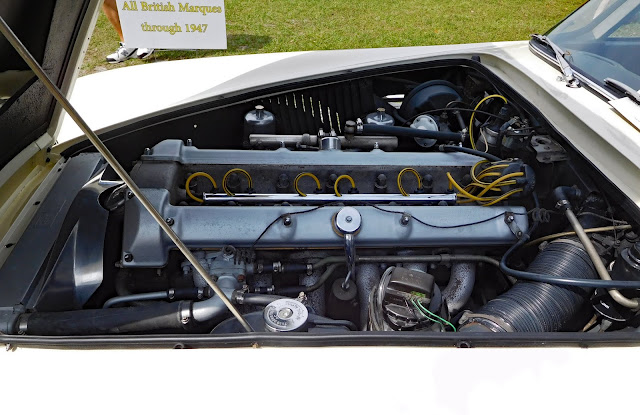April 6, 2019, Winter Springs, Florida
For the 35th consecutive year, the Central Florida British Car Club in Orlando organized this annual event. It has always been referred to as the Mead Gardens because that was the location where it was held - a beautiful city park, filled with trees, in Winter Park, Florida. Some in the leadership of the park did not see the British Cars in the park as a positive situation and ended the opportunity to use Mead Gardens. So, a move was made from Winter Park to Winter Springs, two cities not far apart. Winter Springs is more welcoming. What name will be popularly attached to this car event once known as Mead Gardens? Winter Springs or Central Winds Park or the official title of All British Car Show? Whatever it is called, it is an enjoyable, well-run event.
MGs are always well represented at any All British show. This photo has part of the MGTD group with an MGTF at the end of the line.
The MGA class was small this year. Maybe the other cars were among the group that showed up to Mead Gardens only to find an empty field. This field does represent the three versions of the MGA. The first car is a Mark II which has a 1622 cc engine and low mounted Mini rear lights. The second is a 1600, with a 1600 cc engine and a two element light to meet the US code for separate turn signals. The third is the earliest version of the MGA, the 1500, with a 1500cc engine and single element tail lights.
The field of MGB roadsters were all well-prepared cars.
The hatchback class had both MGBGTs and MGCGTs grouped together. The major difference is that the Bs are powered by an 1800cc 4-cylinder engine, the Cs by a 3000cc 6-cylinder.
The Jaguar XK120, XK140, and XK150 class had all Concours-quality cars. Not just beautiful and well-prepared hobbyist cars, ones that were correct and immaculate down to every nut and bolt.
The finest of the fine were on either end of the line - a fixed-head coupe, and . . .
a drop-head coupe.
There was an even larger field of Jaguar XKEs, believed by many to be one of the most beautiful cars ever produced. One time British Jaguar race car driver, David Hobbs, argues that the Yanks got the name of the car wrong in advertising. It is properly titled Jaguar E-Type.
Ruby was there grouped with the British Modified class, a class for any British manufactured car that has been substantially modified from the form it emerged from the factory.
She was showing off one of her new features, an HCMSL (high center-mounted stop light) as required on all newer cars. It was added as a safety item to give following drivers more warning when the car is stopping/slowing down to avoid rear-end collisions - not a good thing when your gas tank is mounted at the back of the car. It is a period-appropriate light from a 1938 Harley Davidson, mounted in a camouflaged manner. If you haven't before, note the original issue 1949 license plate.
With such a wide variety of cars, a brief glimpse of every make and model is impossible and an in-depth study will only be made on one car, the Austin 7. This Nippy made an entrance onto the showfield with a full-sized black poodle as navigator.
The front license plate announces the year and common name of the sport model of the Austin 7. It was an affordable car for the masses that had a lot of character and appeal.
The Nippy was a 2-seat roadster model making for a quick-handling sports car, sort of the Mazda Miata of its day.
The Austin Tourer could be classified as a 2-door sedan, albeit a tiny one. This car was popularly known in England as the "Chummy."
The owner made a nice presentation of the car with a book of photos documenting the restoration and signs with descriptions of the car.
While the engine is tiny, it is more powerful than the rating. In England, cars were taxed by the horsepower rating, which was mathematically calculated from a sum of the cylinder bores, rather than an actual measurement of the power output. This led to English engines having very long strokes and small bores.
We will end with a quiz. This is an engine in one of the cars in the show. Describe the type of engine and the make of the car.




















